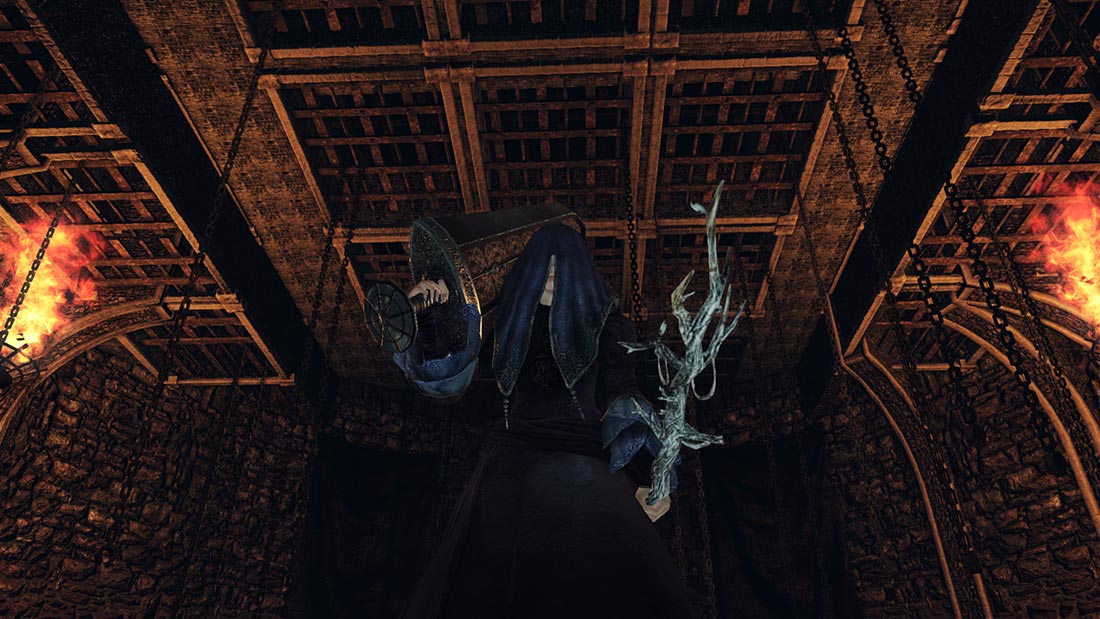Welcome to See Drangleic, an episodic playthrough journal exploring the world of Dark Souls II. Be sure to check out the introduction post first if you haven’t already, otherwise continue reading for Part 8 which explores Sinner’s Rise.
“Anything that has a beginning also has an end. No flame, however brilliant, does not one day splutter and fade.”
Once upon a time, entering Sinner’s Rise immediately revealed yet another irritating design blunder. Just like Lost Bastille before it, Sinner’s Rise featured another dumb bonfire placement, in this case far too close to a group of archers who would happily snipe players before they could even stand up. How FromSoftware managed to blow the basic design formula of ‘bonfire=safe’ twice in such short succession is anyone’s guess, so it was very welcome to see the gaff get corrected in Scholar of the First Sin.
It wasn’t just the archers who disappeared in the remastered version either. A quick wander of the flooded passageway also sees the return of the Flexile Sentry as opposed to the giant Aberrations that used to live here. Whilst I’m in two minds about Souls games re-using their bosses as regular enemies, it does make thematic sense to see the Flexile Sentry here and fighting it amidst the inhibiting water is more tolerable than it was with the Aberrations whose sheer bulk turned this otherwise short run into a slog.
Short is definitely the word though as Sinner’s Rise doesn’t offer much to do outside of a quick elevator ride and the aforementioned spelunking trip through the tower’s depths. The abundance of exploding creatures will cause irritation as does the closing walkway whose narrowness has claimed the lives of countless CPU-controlled phantoms. The highlight here is certainly not the level itself, but then depending on how you look at it, the same could be said for the area’s boss.

Lost Sinner
The Lost Sinner is one of the four Old Ones; a keeper of a Great Soul which players must collect in order to reach the final act. Fighting a boss of this stature would suggest we get to see something special, though similarly to the original Dark Souls, the big bosses in Dark Souls II seem quite easy when compared to the whole cast. The Lost Sinner is found in a spartan prison cell and after witnessing a creepy pre-battle cutscene, players are thrust into another twitch-based slugfest against a humanoid boss wielding a very big sword. Hardly that groundbreaking.
That’s not to say that this boss is pushover. Players who are still dependant on their shield will find their defence severely pressured here as the Sinner’s acrobatic swordplay packs a wallop. Even skilled players aren’t totally secure as the window for counter-attacking the boss following a successful parry is a lot smaller than usual. There’s nothing except physical damage to worry about though, so bulky characters will have a reasonable time taking hits and summoning other phantoms likewise makes things easier.
Also worthy of mention is the environment itself which comes with another of those underused lighting hazards. The boss room is extremely dark inside and if the room is not lit by a suitable lighting source then players will frequently lose their automatic camera lock on the boss which makes defending and attacking at range especially difficult.
However, attentive players will notice two adjoining alcoves before the boss room and these contain a hidden benefit if you can solve the puzzle behind them. Inside each alcove rests a chute filled with oil and if a player lights a torch near one of them then an option appears to ignite the chute, thus filling the boss room with precious light. The bright room looks much nicer and more importantly it also eliminates the targetting malus, making the boss itself much easier to handle.
The problem with this setup in the base game should be obvious by now: the lighting system was so botched that players could quite easily see inside the room without any additional lighting. With little reason to suspect why their camera lock kept deactivating, new players would often be put in an awkward situation here. Accessing the alcoves with the oil chutes was still possible and recommend of course, only the Bastille Key to unlock these rooms was at that time located at the top of Belfry Luna; itself a secret location meaning that players were even less likely to have access to the adjoining puzzle.
The Lost Sinner is one of the few bosses in the game whose tactics change when players undertake a second playthrough. In New Game+ you’ll be assailed by a duo of pyromancers once the boss has sustained a certain amount of damage. Granted, adding more enemies to the scene isn’t an elegant method of increasing difficulty, but as a small way of mixing up a subsequent campaign, it’s a welcome little touch.
If only the battle felt more exciting. The environment looks better with the remaster’s tweaked lighting system and yet the surroundings are still rather bland and the depressing music doesn’t add much excitement either. The Lost Sinner is more interesting from a lore standpoint at least, so overall I’d imagine it’s going to be one of those bosses who gets loved and loathed in equal measure.
Sinner’s Rise concludes with players igniting their first primal bonfire which acts a one-way teleport back to Majula. As discussed earlier in the journal, this is one of the key ways in which the Dark Souls sequels differ from the original. Not everything syncs up as neatly in terms of level design and thus you’ll often come to dead ends like this one with the onus being placed on you to select a new path.
The benefit is that we have free reign to choose our next route, so in the next episode we’ll be asking a mysterious NPC to help us reach a rather inhospitable hunting ground.
Continue to Part 9 »

Leave A Comment